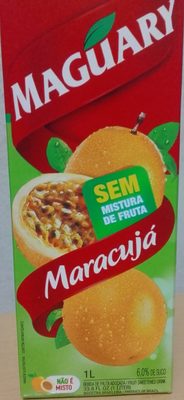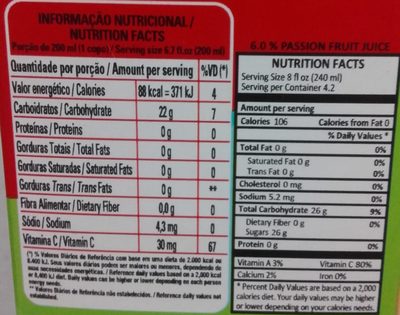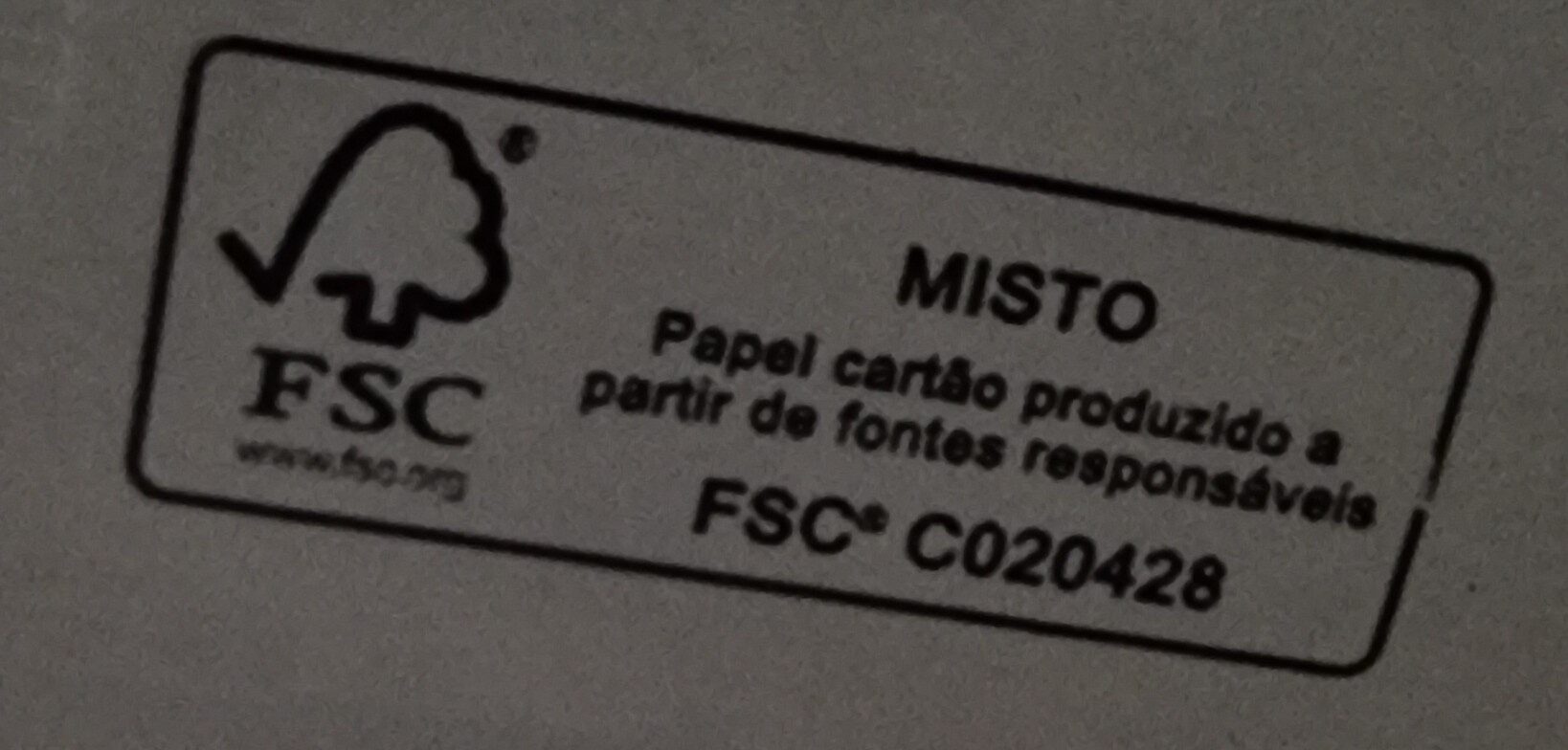Help us make food transparency the norm!
As a non-profit organization, we depend on your donations to continue informing consumers around the world about what they eat.
The food revolution starts with you!
Jus de fruit de la passion - Maguary - 1 l
Jus de fruit de la passion - Maguary - 1 l
This product page is not complete. You can help to complete it by editing it and adding more data from the photos we have, or by taking more photos using the app for Android or iPhone/iPad. Thank you!
×
Barcode: 7896000530363 (EAN / EAN-13)
Common name: Bebida de fruta adoçada - maracujá
Quantity: 1 l
Packaging: Box
Categories: Plant-based foods and beverages, Beverages, Plant-based beverages, Fruit-based beverages, Juices and nectars, Sweetened beverages
Labels, certifications, awards: No gluten
Manufacturing or processing places: Minas Gerais, Ceará, Brasil
Traceability code: FSC-C020428
Link to the product page on the official site of the producer: http://www.maguary.com.br/produto?id=mar...
Stores: Dia
Matching with your preferences
Health
Ingredients
-
20 ingredients
: Água, açúcar, suco integral de maracujá, suco concentrado de maracujá, acidulante: ácido cítrico (INS 330), aroma natural, antioxidante: ácido ascórbico (INS 300), estabilizante: goma xantana (INS 415), corante caroteno: extratos naturais (INS 160 aiii), antiespumante: INS 900a
Food processing
-
Ultra processed foods
Elements that indicate the product is in the 4 - Ultra processed food and drink products group:
- Additive: E160 - Carotenoids
- Additive: E160a - Carotene
- Additive: E415 - Xanthan gum
- Additive: E900 - Dimethylpolysiloxane and Methylphenylpolysiloxane
- Additive: E900a - Dimethyl polysiloxane
- Ingredient: Colour
- Ingredient: Flavouring
Food products are classified into 4 groups according to their degree of processing:
- Unprocessed or minimally processed foods
- Processed culinary ingredients
- Processed foods
- Ultra processed foods
The determination of the group is based on the category of the product and on the ingredients it contains.
Additives
-
E160a - Carotene
Carotene: The term carotene -also carotin, from the Latin carota, "carrot"- is used for many related unsaturated hydrocarbon substances having the formula C40Hx, which are synthesized by plants but in general cannot be made by animals -with the exception of some aphids and spider mites which acquired the synthesizing genes from fungi-. Carotenes are photosynthetic pigments important for photosynthesis. Carotenes contain no oxygen atoms. They absorb ultraviolet, violet, and blue light and scatter orange or red light, and -in low concentrations- yellow light. Carotenes are responsible for the orange colour of the carrot, for which this class of chemicals is named, and for the colours of many other fruits, vegetables and fungi -for example, sweet potatoes, chanterelle and orange cantaloupe melon-. Carotenes are also responsible for the orange -but not all of the yellow- colours in dry foliage. They also -in lower concentrations- impart the yellow coloration to milk-fat and butter. Omnivorous animal species which are relatively poor converters of coloured dietary carotenoids to colourless retinoids have yellowed-coloured body fat, as a result of the carotenoid retention from the vegetable portion of their diet. The typical yellow-coloured fat of humans and chickens is a result of fat storage of carotenes from their diets. Carotenes contribute to photosynthesis by transmitting the light energy they absorb to chlorophyll. They also protect plant tissues by helping to absorb the energy from singlet oxygen, an excited form of the oxygen molecule O2 which is formed during photosynthesis. β-Carotene is composed of two retinyl groups, and is broken down in the mucosa of the human small intestine by β-carotene 15‚15'-monooxygenase to retinal, a form of vitamin A. β-Carotene can be stored in the liver and body fat and converted to retinal as needed, thus making it a form of vitamin A for humans and some other mammals. The carotenes α-carotene and γ-carotene, due to their single retinyl group -β-ionone ring-, also have some vitamin A activity -though less than β-carotene-, as does the xanthophyll carotenoid β-cryptoxanthin. All other carotenoids, including lycopene, have no beta-ring and thus no vitamin A activity -although they may have antioxidant activity and thus biological activity in other ways-. Animal species differ greatly in their ability to convert retinyl -beta-ionone- containing carotenoids to retinals. Carnivores in general are poor converters of dietary ionone-containing carotenoids. Pure carnivores such as ferrets lack β-carotene 15‚15'-monooxygenase and cannot convert any carotenoids to retinals at all -resulting in carotenes not being a form of vitamin A for this species-; while cats can convert a trace of β-carotene to retinol, although the amount is totally insufficient for meeting their daily retinol needs.Source: Wikipedia
-
E330 - Citric acid
Citric acid is a natural organic acid found in citrus fruits such as lemons, oranges, and limes.
It is widely used in the food industry as a flavor enhancer, acidulant, and preservative due to its tart and refreshing taste.
Citric acid is safe for consumption when used in moderation and is considered a generally recognized as safe (GRAS) food additive by regulatory agencies worldwide.
-
E415 - Xanthan gum
Xanthan gum (E415) is a natural polysaccharide derived from fermented sugars, often used in the food industry as a thickening and stabilizing agent.
This versatile food additive enhances texture and prevents ingredient separation in a wide range of products, including salad dressings, sauces, and gluten-free baked goods.
It is considered safe for consumption even at high intake amounts.
-
E900 - Dimethylpolysiloxane and Methylphenylpolysiloxane
Polydimethylsiloxane: Polydimethylsiloxane -PDMS- belongs to a group of polymeric organosilicon compounds that are commonly referred to as silicones. PDMS is the most widely used silicon-based organic polymer, and is particularly known for its unusual rheological -or flow- properties. PDMS is optically clear, and, in general, inert, non-toxic, and non-flammable. It is also called dimethylpolysiloxane or dimethicone and is one of several types of silicone oil -polymerized siloxane-. Its applications range from contact lenses and medical devices to elastomers; it is also present in shampoos -as dimethicone makes hair shiny and slippery-, food -antifoaming agent-, caulking, lubricants and heat-resistant tiles.Source: Wikipedia
-
E900a - Dimethyl polysiloxane
Polydimethylsiloxane: Polydimethylsiloxane -PDMS- belongs to a group of polymeric organosilicon compounds that are commonly referred to as silicones. PDMS is the most widely used silicon-based organic polymer, and is particularly known for its unusual rheological -or flow- properties. PDMS is optically clear, and, in general, inert, non-toxic, and non-flammable. It is also called dimethylpolysiloxane or dimethicone and is one of several types of silicone oil -polymerized siloxane-. Its applications range from contact lenses and medical devices to elastomers; it is also present in shampoos -as dimethicone makes hair shiny and slippery-, food -antifoaming agent-, caulking, lubricants and heat-resistant tiles.Source: Wikipedia
Ingredients analysis
-
May contain palm oil
Ingredients that may contain palm oil: E160a
-
Vegan status unknown
Unrecognized ingredients: pt:suco-integral-de-maracuja, pt:suco-concentrado-de-maracuja, pt:acidulante, pt:extratos-naturais, pt:e160-aiii, pt:antiespumanteSome ingredients could not be recognized.
We need your help!
You can help us recognize more ingredients and better analyze the list of ingredients for this product and others:
- Edit this product page to correct spelling mistakes in the ingredients list, and/or to remove ingredients in other languages and sentences that are not related to the ingredients.
- Add new entries, synonyms or translations to our multilingual lists of ingredients, ingredient processing methods, and labels.
If you would like to help, join the #ingredients channel on our Slack discussion space and/or learn about ingredients analysis on our wiki. Thank you!
-
Vegetarian status unknown
Unrecognized ingredients: pt:suco-integral-de-maracuja, pt:suco-concentrado-de-maracuja, pt:acidulante, pt:extratos-naturais, pt:e160-aiii, pt:antiespumanteSome ingredients could not be recognized.
We need your help!
You can help us recognize more ingredients and better analyze the list of ingredients for this product and others:
- Edit this product page to correct spelling mistakes in the ingredients list, and/or to remove ingredients in other languages and sentences that are not related to the ingredients.
- Add new entries, synonyms or translations to our multilingual lists of ingredients, ingredient processing methods, and labels.
If you would like to help, join the #ingredients channel on our Slack discussion space and/or learn about ingredients analysis on our wiki. Thank you!
-
Details of the analysis of the ingredients
We need your help!
Some ingredients could not be recognized.
We need your help!
You can help us recognize more ingredients and better analyze the list of ingredients for this product and others:
- Edit this product page to correct spelling mistakes in the ingredients list, and/or to remove ingredients in other languages and sentences that are not related to the ingredients.
- Add new entries, synonyms or translations to our multilingual lists of ingredients, ingredient processing methods, and labels.
If you would like to help, join the #ingredients channel on our Slack discussion space and/or learn about ingredients analysis on our wiki. Thank you!
: Água, açúcar, suco integral de maracujá, suco concentrado de maracujá, acidulante (ácido cítrico (e330)), aroma natural, antioxidante (ácido ascórbico (e300)), estabilizante (goma xantana (e415)), corante (caroteno), extratos naturais (e160 aiii), antiespumante (e900a)- Água -> en:water - vegan: yes - vegetarian: yes - ciqual_food_code: 18066 - percent_min: 26 - percent_max: 100
- açúcar -> en:sugar - vegan: yes - vegetarian: yes - ciqual_proxy_food_code: 31016 - percent_min: 0 - percent_max: 11
- suco integral de maracujá -> pt:suco-integral-de-maracuja - percent_min: 0 - percent_max: 11
- suco concentrado de maracujá -> pt:suco-concentrado-de-maracuja - percent_min: 0 - percent_max: 11
- acidulante -> pt:acidulante - percent_min: 0 - percent_max: 11
- ácido cítrico -> en:e330 - vegan: yes - vegetarian: yes - percent_min: 0 - percent_max: 11
- e330 -> en:e330 - vegan: yes - vegetarian: yes - percent_min: 0 - percent_max: 11
- ácido cítrico -> en:e330 - vegan: yes - vegetarian: yes - percent_min: 0 - percent_max: 11
- aroma natural -> en:natural-flavouring - vegan: maybe - vegetarian: maybe - percent_min: 0 - percent_max: 5
- antioxidante -> en:antioxidant - percent_min: 0 - percent_max: 5
- ácido ascórbico -> en:e300 - vegan: yes - vegetarian: yes - percent_min: 0 - percent_max: 5
- e300 -> en:e300 - vegan: yes - vegetarian: yes - percent_min: 0 - percent_max: 5
- ácido ascórbico -> en:e300 - vegan: yes - vegetarian: yes - percent_min: 0 - percent_max: 5
- estabilizante -> en:stabiliser - percent_min: 0 - percent_max: 5
- goma xantana -> en:e415 - vegan: yes - vegetarian: yes - percent_min: 0 - percent_max: 5
- e415 -> en:e415 - vegan: yes - vegetarian: yes - percent_min: 0 - percent_max: 5
- goma xantana -> en:e415 - vegan: yes - vegetarian: yes - percent_min: 0 - percent_max: 5
- corante -> en:colour - percent_min: 0 - percent_max: 5
- caroteno -> en:e160a - vegan: maybe - vegetarian: maybe - from_palm_oil: maybe - percent_min: 0 - percent_max: 5
- extratos naturais -> pt:extratos-naturais - percent_min: 0 - percent_max: 5
- e160 aiii -> pt:e160-aiii - percent_min: 0 - percent_max: 5
- antiespumante -> pt:antiespumante - percent_min: 0 - percent_max: 5
- e900a -> en:e900a - vegan: yes - vegetarian: yes - percent_min: 0 - percent_max: 5
Nutrition
-
Bad nutritional quality
⚠ ️Warning: the amount of fruits, vegetables and nuts is not specified on the label, it was estimated from the list of ingredients: 0This product is considered a beverage for the calculation of the Nutri-Score.
Positive points: 0
- Proteins: 0 / 5 (value: 0, rounded value: 0)
- Fiber: 0 / 5 (value: 0, rounded value: 0)
- Fruits, vegetables, nuts, and colza/walnut/olive oils: 0 / 10 (value: 0, rounded value: 0)
Negative points: 15
- Energy: 7 / 10 (value: 184, rounded value: 184)
- Sugars: 8 / 10 (value: 11, rounded value: 11)
- Saturated fat: 0 / 10 (value: 0, rounded value: 0)
- Sodium: 0 / 10 (value: 0, rounded value: 0)
The points for proteins are not counted because the negative points are greater or equal to 11.
Nutritional score: (15 - 0)
Nutri-Score:
-
Nutrient levels
-
Fat in low quantity (0%)
What you need to know- A high consumption of fat, especially saturated fats, can raise cholesterol, which increases the risk of heart diseases.
Recommendation: Limit the consumption of fat and saturated fat- Choose products with lower fat and saturated fat content.
-
Saturated fat in low quantity (0%)
What you need to know- A high consumption of fat, especially saturated fats, can raise cholesterol, which increases the risk of heart diseases.
Recommendation: Limit the consumption of fat and saturated fat- Choose products with lower fat and saturated fat content.
-
Sugars in high quantity (11%)
What you need to know- A high consumption of sugar can cause weight gain and tooth decay. It also augments the risk of type 2 diabetes and cardio-vascular diseases.
Recommendation: Limit the consumption of sugar and sugary drinks- Sugary drinks (such as sodas, fruit beverages, and fruit juices and nectars) should be limited as much as possible (no more than 1 glass a day).
- Choose products with lower sugar content and reduce the consumption of products with added sugars.
-
Salt in low quantity (0%)
What you need to know- A high consumption of salt (or sodium) can cause raised blood pressure, which can increase the risk of heart disease and stroke.
- Many people who have high blood pressure do not know it, as there are often no symptoms.
- Most people consume too much salt (on average 9 to 12 grams per day), around twice the recommended maximum level of intake.
Recommendation: Limit the consumption of salt and salted food- Reduce the quantity of salt used when cooking, and don't salt again at the table.
- Limit the consumption of salty snacks and choose products with lower salt content.
-
-
Nutrition facts
Nutrition facts As sold
for 100 g / 100 mlAs sold
per serving (200 ml)Compared to: Sweetened beverages Energy 184 kj
(44 kcal)368 kj
(88 kcal)-30% Fat 0 g 0 g -100% Saturated fat 0 g 0 g -100% Carbohydrates 11 g 22 g -21% Sugars 11 g 22 g -15% Fiber 0 g 0 g -100% Proteins 0 g 0 g -100% Salt 0 g 0 g -100% Vitamin C (ascorbic acid) 30 mg 60 mg +89% Fruits‚ vegetables‚ nuts and rapeseed‚ walnut and olive oils (estimate from ingredients list analysis) 0 % 0 %
Environment
-
Eco-Score C - Moderate environmental impact
⚠ ️Select a country in order to include the full impact of transportation.The Eco-Score is an experimental score that summarizes the environmental impacts of food products.→ The Eco-Score was initially developped for France and it is being extended to other European countries. The Eco-Score formula is subject to change as it is regularly improved to make it more precise and better suited to each country.Life cycle analysis
-
Average impact of products of the same category: B (Score: 64/100)
Category: Fruit soft drink, still (fruit juice content unspecified), with sugar
Category: Fruit soft drink, still (fruit juice content unspecified), with sugar
- PEF environmental score: 0.10 (the lower the score, the lower the impact)
- including impact on climate change: 0.56 kg CO2 eq/kg of product
Stage Impact Agriculture
29.5 %Processing
4.9 %Packaging
39.1 %Transportation
15.1 %Distribution
9.0 %Consumption
2.5 %
Bonuses and maluses
-
Missing origins of ingredients information
Malus: -5
⚠ ️ The origins of the ingredients of this product are not indicated.
If they are indicated on the packaging, you can modify the product sheet and add them.
If you are the manufacturer of this product, you can send us the information with our free platform for producers.
-
Packaging with a medium impact
Malus: -10
Shape Material Recycling Impact Box Unknown High ⚠ ️ The information about the packaging of this product is not sufficiently precise (exact shapes and materials of all components of the packaging).⚠ ️ For a more precise calculation of the Eco-Score, you can modify the product page and add them.
If you are the manufacturer of this product, you can send us the information with our free platform for producers.
Eco-Score for this product
-
Impact for this product: C (Score: 49/100)
Product: Jus de fruit de la passion - Maguary - 1 l
Life cycle analysis score: 64
Sum of bonuses and maluses: -15
Final score: 49/100
-
Carbon footprint
-
Equal to driving 0.3 km in a petrol car
56 g CO² per 100g of product
The carbon emission figure comes from ADEME's Agribalyse database, for the category: Fruit soft drink, still (fruit juice content unspecified), with sugar (Source: ADEME Agribalyse Database)
Stage Impact Agriculture
16.3 %Processing
10.6 %Packaging
31.7 %Transportation
33.9 %Distribution
6.3 %Consumption
1.2 %
Packaging
-
Packaging with a medium impact
-
Packaging parts
Box
-
Packaging materials
Material % Packaging weight Packaging weight per 100 g of product
-
Transportation
-
Origins of ingredients
Missing origins of ingredients information
⚠ ️ The origins of the ingredients of this product are not indicated.
If they are indicated on the packaging, you can modify the product sheet and add them.
If you are the manufacturer of this product, you can send us the information with our free platform for producers.Add the origins of ingredients for this product Add the origins of ingredients for this product
Report a problem
-
Incomplete or incorrect information?
Category, labels, ingredients, allergens, nutritional information, photos etc.
If the information does not match the information on the packaging, please complete or correct it. Open Food Facts is a collaborative database, and every contribution is useful for all.
Data sources
Product added on by victor53
Last edit of product page on by roboto-app.
Product page also edited by idkplog, kiliweb, openfoodfacts-contributors, packbot, yuka.UklZaENJa0V1cUJVdXNjUDhVbit3dEYvNFptM2NWdTlMYkJNSUE9PQ.












